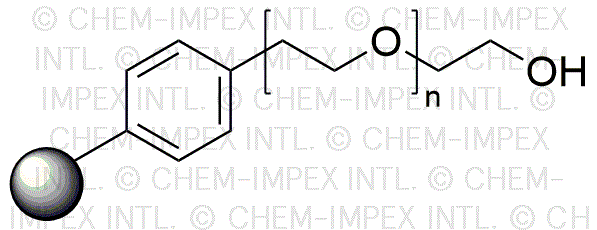TentaGel HL OH (0.4 - 0.6 mmol/g, 110 µm) is widely utilized in research focused on:
- Solid-Phase Synthesis: This chemical is essential for solid-phase peptide synthesis, allowing researchers to create peptides efficiently while minimizing side reactions.
- Drug Development: It plays a crucial role in the development of drug candidates by facilitating the synthesis of combinatorial libraries, enabling the identification of potential therapeutic agents.
- Bioconjugation: TentaGel HL OH is used in bioconjugation processes, where it helps attach biomolecules to surfaces or other molecules, enhancing the functionality of drugs and diagnostics.
- Analytical Chemistry: It serves as a support material in various chromatographic techniques, improving the separation and analysis of complex mixtures in research laboratories.
- Material Science: The chemical is also applied in the development of new materials, such as hydrogels, which can be used in drug delivery systems and tissue engineering applications.
General Information
Properties
Safety and Regulations
Applications
TentaGel HL OH (0.4 - 0.6 mmol/g, 110 µm) is widely utilized in research focused on:
- Solid-Phase Synthesis: This chemical is essential for solid-phase peptide synthesis, allowing researchers to create peptides efficiently while minimizing side reactions.
- Drug Development: It plays a crucial role in the development of drug candidates by facilitating the synthesis of combinatorial libraries, enabling the identification of potential therapeutic agents.
- Bioconjugation: TentaGel HL OH is used in bioconjugation processes, where it helps attach biomolecules to surfaces or other molecules, enhancing the functionality of drugs and diagnostics.
- Analytical Chemistry: It serves as a support material in various chromatographic techniques, improving the separation and analysis of complex mixtures in research laboratories.
- Material Science: The chemical is also applied in the development of new materials, such as hydrogels, which can be used in drug delivery systems and tissue engineering applications.
Documents
Safety Data Sheets (SDS)
The SDS provides comprehensive safety information on handling, storage, and disposal of the product.
Product Specification (PS)
The PS provides a comprehensive breakdown of the product’s properties, including chemical composition, physical state, purity, and storage requirements. It also details acceptable quality ranges and the product's intended applications.
Certificates of Analysis (COA)
Search for Certificates of Analysis (COA) by entering the products Lot Number. Lot and Batch Numbers can be found on a product’s label following the words ‘Lot’ or ‘Batch’.
Numéro de catalogue
Numéro de lot/série
Certificates Of Origin (COO)
This COO confirms the country where the product was manufactured, and also details the materials and components used in it and whether it is derived from natural, synthetic, or other specific sources. This certificate may be required for customs, trade, and regulatory compliance.
Numéro de catalogue
Numéro de lot/série
Safety Data Sheets (SDS)
The SDS provides comprehensive safety information on handling, storage, and disposal of the product.
DownloadProduct Specification (PS)
The PS provides a comprehensive breakdown of the product’s properties, including chemical composition, physical state, purity, and storage requirements. It also details acceptable quality ranges and the product's intended applications.
DownloadCertificates of Analysis (COA)
Search for Certificates of Analysis (COA) by entering the products Lot Number. Lot and Batch Numbers can be found on a product’s label following the words ‘Lot’ or ‘Batch’.
Numéro de catalogue
Numéro de lot/série
Certificates Of Origin (COO)
This COO confirms the country where the product was manufactured, and also details the materials and components used in it and whether it is derived from natural, synthetic, or other specific sources. This certificate may be required for customs, trade, and regulatory compliance.

